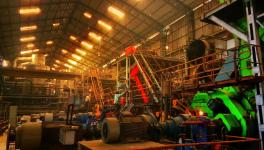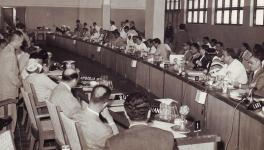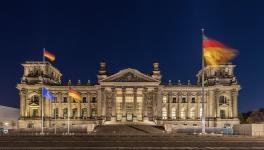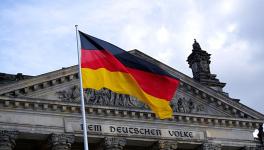Marx in Brussels
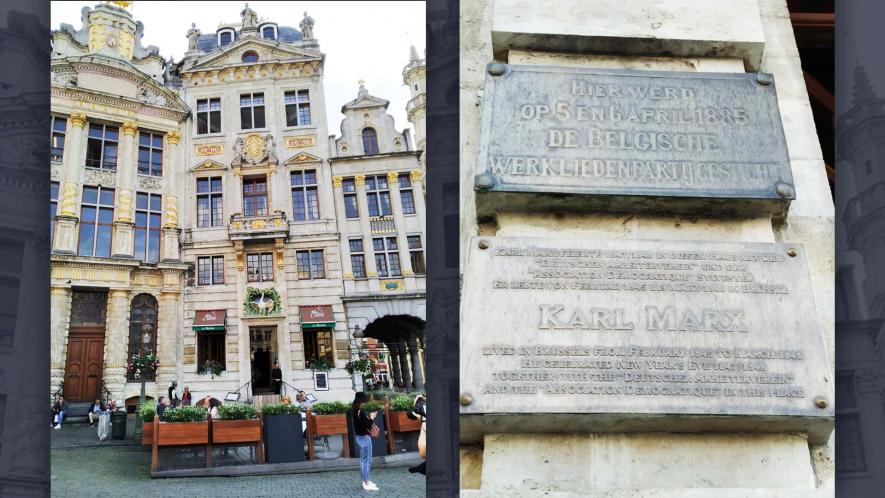
Karl Marx
Lived in Brussels from February 1845 to March 1848
He celebrated New Year's Eve 1947/48 together with the "Deutscher Arbeiterverein" and the "Association Democratique" in this place
The plaque put on a building which housed a restaurant 'Le Cygne, The Swan' now is the only memory left of the days when history was 'made' here. According to legend, it is the same place '[w]here the First International had convened' and Marx and his lifelong friend and comrade Engels '[h]ad written the Communist Manifesto'.
No doubt it was the same place when Marx, Engels, Mozes Hess - who was another early luminary of socialism and who supposedly had influenced Engels about communism - and other associates of the surging workers movement pondered over many of those ideas which have been memorialised in the opening sentences of the Manifesto, “A spectre is haunting Europe — the spectre of communism....”
May be the historic slogan 'Workers of the World Unite, You have nothing to lose but your chains' which later reverberated throughout the world - whose echoes are still heard - had its 'humble' beginning in one of those very rooms, where Marx and his close associates used to educate workers about their exploitation.
Scores of people sitting in this particular restaurant which was serving them sumptuous food and choicest drinks were completely oblivious of all those details. Few of them rather looked at us with a sense of disbelief and dismay, when they witnessed us taking photos of the nondescript wall which had the plaque put on it. Perhaps they looked more satisfied that they are enjoying food at a place which is situated on the Grand Place or Grote Markt, which is the central square of Brussels and is considered one of the most beautiful squares in Europe and is also part of UN Heritage.
Thousands of tourists from different parts of the world - had also literally thronged at 'this most beautiful square in Europe' and were busy taking photographs of themselves as well as the historic buildings which surround the place. Of course, most of them were seen around the historic Town Hall, which is the central edifice on the Grand Place. Counted as the square's only medieval building which still remains, it was constructed between 1402 and 1455. None of the tourists had shown any curiosity to come to this particular restaurant to see the building which stands merely a few metres away in the same square. Few of them were rather keen to watch a young couple which was getting intimate completely oblivious of the crowd surrounding them.
Interestingly, there was another plaque as well placed just above this one which said that the founding conference of the Belgian Workers’ Party was held in this building itself in the year 1885 in the month of April. Around 112 workers - mainly craftsmen - had participated in this meeting.
As an aside, one needs to mention here that the Belgian Workers’ Party was instrumental not only in building a strong workers’ movement in the country but had also to its credit the building of a centre for free speech, healthcare and legal advice called “Maison du Peuple” (The People's House), a first of its kind in Europe which was inaugurated in the presence of the French socialist leader Jean Jaures (1899). The party had commissioned a leading architect Victor Horta for this work which being an experimental combination of brick, glass, and steel was considered a 'masterwork of modern architecture.' Inspired by this building, the Dutch socialists also endeavoured to build a structure on similar lines which was followed by others as well.
Also watch: Marx200: Break the Chains
It is a different matter that despite resistance by hundreds of leading architects from all over the world, the government demolished ‘The People's House’ in 1965 and a skyscraper was built on its site under its programme of - what is derisively called as 'Brusselisation' - which resulted in the demolition of many other historic buildings.
Lets look back at what made Brussels an ideal place for Marx to stay, largely uninterrupted, for more than three years after being externed from France by Guizot in 1845. Thanks to the most liberal constitution which Belgium then had in whole of Europe at that time, Marx could enjoy the freedom of speech which was facing increasing restrictions elsewhere. The '[c]entral location of Brussels and the modern railway system and postal services' also helped him '[n]etwork with his friends and communist colleagues in France, Germany and England.'
By March 1848, the patience of the Belgian authorities was also over and Marx was expelled by them 'under the influence of the panic caused by the February revolution' and Marx had to flee the country. His wanderings from this country to the next continued for a while as authorities felt deeply annoyed with his ideas and activities till August 1849 when he landed in London, where he stayed for the rest of his life.
Historian Edward de Maesschalck has in fact written a book Marx in Brussels (2005) which retraces Marx’s footsteps in Brussels. One learns that Marx and his wife and their three children lived at five different places in the city; most of these places do not exist any more. ‘However, in Ixelles, there is still a commemorative plaque on his former home at 50, Rue Jean d'Ardennes, where he almost certainly wrote the Communist Manifesto’. Steven Hermans who has written about Karl Marx's Revolutionary Brussels and who had looked for clues of Karl Marx there, describes a road where '[M]arx lived at number 5, in a run-down worker’s house. Next to him, at number 3, lived Friedrich Engels,’ and, ‘At number 7 lived another early luminary of socialism, Mozes Hess.’
Every student of progressive politics knows that for young Marx this stay in Brussels was one of the most productive times of his life. It was here that he wrote his famous book Poverty of Philosophy, where he critiqued the economic and philosophic doctrines of Proudhon - then a well-known French political economist and 'acknowledged by Bakunin as the founder of anarchism, who had envisioned a society of independent, self-employed artisans.' A cursory glance at the correspondence between Engels and Marx makes it clear that Marx had started work on this book in January 1847 and had finished it by April 1847.
One can also revisit Marx’s famous debates with William Weitling, the German born tailor, inventor and radical political activist, during this period. Weitling’s ideas were once a rage in the nascent socialist circles, so much so that they had attracted thousands of dedicated disciples across the continent and whom Marx himself had admired for the "vehement and brilliant literary debut of the German workers,"1 in an article in 1844. Later Weitling, who traced communism back to early Christianity, in his 1847 book Gospel of Poor Sinners was roundly criticised by him for his 'moralistic appeals'.
The most remarkable aspect of this period in Brussels was the penning down of the Communist Manifesto, which firmly established Marx as well as Engels as the intellectual leaders of the working class movement.
It is now history how the League of the Just, which was basically a secret society of German emigres living in London, invited Marx to join the organisation, which was joined by both Marx as well as Engels. The League of the Just - was renamed as Communist League by Engels who envisaged uniting with other German workers spread across Europe. The League commissioned the duo to draw up a manifesto which could be presented as doctrines of the League. Despite repeated reminders from the League when the duo could not finish the Manifesto, the League sent them an ultimatum by end of January 1848, asking them to finish it by first week of February, which was then finished by them in the stipulated time.
The publication of the Manifesto which boldly claimed, "The history of all hitherto existing society is the history of class struggles," also happened to be an occasion when revolutions broke out in many countries of Europe - which did face reversals in a short period - further consolidated their key role in the movement of the exploited.
As we were leaving the historic Grand Place, we once again tried to have a look at the plaque, as if we wanted to say goodbye to that place and were amazed to see a group of youngsters jostling with each other to stand below the plaque and get themselves photographed, bringing little cheer to our faces.
1. Critical Marginal Notes on the Article "The King of Prussia and Social Reform," in The Marx-Engels Reader, 2nd ed., ed. Robert C. Tucker (New York: Norton, 1978), p. 129.
Get the latest reports & analysis with people's perspective on Protests, movements & deep analytical videos, discussions of the current affairs in your Telegram app. Subscribe to NewsClick's Telegram channel & get Real-Time updates on stories, as they get published on our website.











